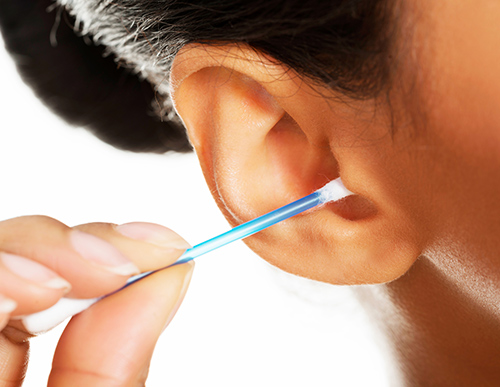
The American Academy of Otolaryngology-Head and Neck Surgery (AAO-HNS) has frequently endorsed the warning on your very own box of swabs—do not stick them into your ears! Your grandmother was right all along: never stick anything smaller than your elbow into your ear. (You’re trying to do it now, aren’t you?)
In addition to your grandmother and the AAO-HNS, please listen to your hearing care professional and peruse these 5 reasons you need to stop cleaning out your ears yesterday:
1. Your Ears Already Clean Themselves Very Well, Thank You
Cerumen (ear wax) is actually the very thing that cleans out your ears every day. It traps dirt and debris before it can go deeper into the ear canal and get trapped. As you talk, yawn and chew throughout the day, these mechanical motions of you using your jaw actually funnels soiled ear wax down and out of the ear canal, effectively pushing out the dirt. Using a swab, key, chopstick, pencil or any other foreign implement to remove the cerumen can actually reverse your ears’ self-cleaning process, pushing used ear wax deeper into the canal where it can get impacted and cause hearing loss or injury.
2. Ear Wax Protects Your Ears
Cerumen has many other very helpful properties besides just moving the dirt out of your ears. It lubricates the ear canal and also protects your ears against viruses, bacteria, fungal infections and even insect invasion!
Cerumen is an interesting mixture of fatty acids, cholesterol, alcohols, sebum, sloughed off skin cells, enzymes and other chemicals that are produced by special glands inside your ears. Your ears excrete this special protective concoction to keep your ears clean and infection free. In fact, average cerumen is slightly acidic, which also inhibits bacterial and fungal growth inside of your ear canal.
3. Excessive Ear Cleaning May Make Hearing Loss Worse
If you’ve spent most of your life swabbing ear wax out of your ears without understanding these things, you’re not alone. Be aware, however, that you’ve likely jammed old ear wax down into your ear canal, which can worsen your hearing. Put down the swab and back away slowly—it’s not for ear cleaning! If you have concerns, schedule an appointment with your hearing care professional to have them check whether you have impacted ear wax that might be causing some hearing loss.
Now, some people do actually make excess ear wax, and some people make too little. Sometimes the chemical composition of the ear wax isn’t ideal—it may be too wet or too dry. Either way, it’s still a bad idea to use anything bigger than your elbow for ear wax removal. If you have any concerns about your ears’ cerumen production, again, please schedule an appointment with your hearing care professional.
Using hearing aids can also impact ear wax. To avoid this, be sure to follow your hearing care professional’s recommendations on gentle ear washing and regular cleaning of your hearing aids to keep the balance right and your hearing clear.
4. Other Ear Cleaning Injuries to Avoid
On average, about 34 American children go to the doctor every day for ear cleaning injuries. Sometimes the well-meaning parents do it, thinking ear cleaning is as necessary as brushing the teeth. But often the kids do it themselves. The most common of these injuries include tympanic membrane tears (torn ear drum) or other small cuts and lacerations inside the ear canal.
But children aren’t the only ones coming in with ear injuries from ear wax removal mishaps. Thousands of people go to the doctor with “ear candling” injuries every year too. Seen as a “natural ear wax removal” technique, ear candling enthusiasts stick a hollow, cone-shaped candle into their ear canals and light it. Here’s what you need to know about ear candling:
- It’s ineffective at best for ear cleaning and can actually worsen ear wax impaction.
- It causes burn injuries to the face, ears, hair, etc. – even burns that go all the way to the ear drum and middle ear.
- It’s also been known to puncture the ear drum.
Just say no to ear candling!
5. If You Can’t Help Yourself…
All you really need to do is gently dab your ears dry with a towel after your daily shower and hair washing routine. Normally, this is entirely sufficient for healthy ear cleaning. But if you have any concerns about your ear health, excess ear wax, impaction, ear injury or hearing loss, schedule an appointment with your hearing care professional today for appropriate care.